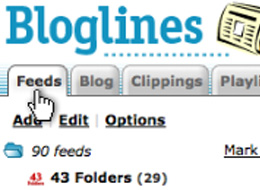RIP Bloglines
The once innovative and popular online RSS and news aggregator Bloglines will discontinue service on Friday, October 1. The Ask.com team that operates the site has essentially said that social media sites like Twitter and Facebook killed it. Bloglines was the first feed reader I ever used, and I still have a 'subscribe with Bloglines' badge on the right sidebar, (don't worry if you can't find it, I don't think anyone else has either).
a 'subscribe with Bloglines' badge on the right sidebar, (don't worry if you can't find it, I don't think anyone else has either).
From a blog post on the Ask.com site, the underlying reasoning behind the shutdown of Bloglines is as follows:
...when we originally acquired Bloglines in 2005, RSS was in its infancy. The concept of “push” versus “search” around information consumption had become very real, and we were bullish about the opportunity Bloglines presented for our users. Flash forward to 2010. The Internet has undergone a major evolution. The real-time information RSS was so astute at delivering (primarily, blog feeds) is now gained through conversations, and consuming this information has become a social experience. As Steve Gillmor pointed out in TechCrunch last year , being locked in an RSS reader makes less and less sense to people as Twitter and Facebook dominate real-time information flow. Today RSS is the enabling technology – the infrastructure, the delivery system. RSS is a means to an end, not a consumer experience in and of itself.
To me the money quote in the post from Ask.com is the line about 'being locked in an RSS reader makes less and less sense to people. RSS readers (and for the remainder of this post, let's just use Google Reader as our example, since I am 99% certain no one is reading this post in any other RSS client or application), offer the powerful capability of delivering to you the news items, blog posts, and other website updates automatically, in a persistent manner, and make them easily consumable on your schedule (or just as easily ignored).
They were, and still mostly are, a private and personal kind of experience. Sure Google Reader has built in additional capabilities for sharing items with people that are following you on Reader, and for connecting these shared items with Google Buzz and Twitter. But some of these integrations require several manual interventions, and you have to admit if you are someone that has linked their shared items on Google Reader to your Twitter account to automatically Tweet, you are solidly outside the mainstream of the average blog reader. And in terms of the uptake of 'following' on Reader, as of this writing I have 4,613 followers on Twitter, and 68 on Google Reader. Your mileage may vary. But a 'shared item' on Reader connects with me in a way that a Facebook post or a Tweet doesn't, in Reader I am pretty sure my contact actually read the piece before propagating it to their connections.
Ask.com is making the determination (that very well may be true, it is hard to know), that simply consuming content in an RSS Reader is no longer 'good enough'. We have, as users, to be able to easily spread that content out across our social networks like Twitter and Facebook, and in turn, we need to be able to mine our networks to find and consume content pushed or shared by our connections. That news item, blog post, or funny video of kitty antics accrues more value to us, and to the network, the more that is is shared and circulated. I get it, in fact that is pretty obvious. I would love this post to get widely shared around the social web, passed from Tweet, to Facebook wall, to Google Buzz, and back around again in a self-sustaining frenzy of consumption.
But before any of that can happen, I need someone to actually read the post first.
Which is exactly the capability that Bloglines was and Google Reader still is, so good at. It is sad to me to see Bloglines disappear, but what would be worse I think is if we stop focusing on engaging with good content individually, personally, and for our own development and understanding while anxiously seeking out the Retweet button. Great content absolutely should be shared, but it needs to resonate with you first, and if RSS devolves into just the plumbing for sharing content, then I think some of that connection will get lost.
By the way, the Retweet and Like buttons are at the end of the post.
I know, I am a hypocrite. RIP Bloglines.

 Steve
Steve



